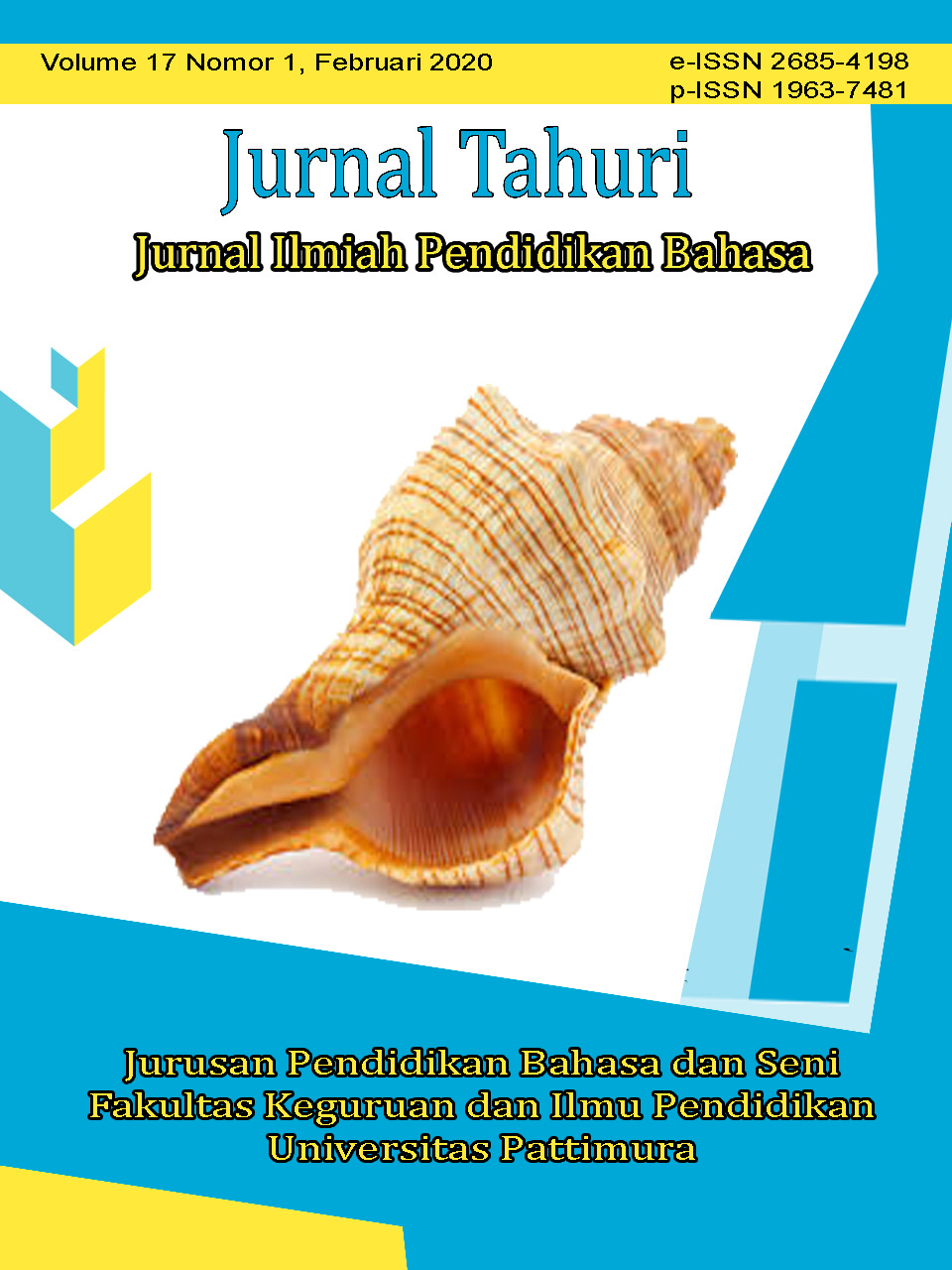EXPLORING CAUSES AND ALLEVIATING STRATEGIES OF ENGLISH STUDENT-TEACHERS’ WRITING ANXIETY AT PATTIMURA UNIVERSITY
Abstract
There have been couples of studies reporting on English students-teachers’ writing anxiety. However, there has been little information on what factors contribute to Indonesian EFL Pre-service teachers’ writing anxiety and how they overcome it. This study aimed at figuring out the facts of related causes of anxiety and alleviating strategies that English student-teachers in English teachers at Pattimura University Ambon employ when they write in English language. The research design is both quantitative and qualitative methods. The data were collected from questionnaires and in-depth interview. The results reveal some contributing factors to participants’ writing anxiety including linguistic difficulties, time pressure, lack of writing practices, instructors’ evaluation and pressure for a perfect work. Furthermore, to overcome their problems, the participants utilize the rethorical, cognitive and socio-affective strategies. The study, then, concludes that by recognizing the causes of writing anxiety, the participants may work better on applying strategies that can reduce their level of writing anxiety
Downloads
References
Alluhaybi, M. (2015). Psychology and EFL Writing. Procedia-Social and Behavioral Science. Elsevier Ltd.
Amabile, T. et all. (2002). Time Pressure and Creativity in Organization: A Longitudinal Study.
Bloom, L. Z. (1981). Why Graduate Students Can’t Write: Implications of Research on Writing Anxiety for Graduate Education. Journal of Advanced Composition.
Brown, D. (2000). Principle in Learning and Teaching 4th Edt. NY: Pearson Brown, D. (2001) Teaching by Principles. An interactive approach to language pedagogy 2nd Edt. NY: Pearson
Cheng, Y. (2002). Factors Associated with Foreign Language Writing Anxiety. Foreign Language Annals. Vol. 35. No. 5. National Taiwan Normal University.
Cheng, Y. (2004a). EFL Students’ Writing Anxiety: Sources and Implications. English Teaching of Learning. National Taiwan Normal University.
Cheng, Y. (2004b). A measure of second language writing anxiety: Scale development and preliminary validation. Journal of Second Language Writing. National Taiwan Normal
Craft, L. L. et al. (2003). The Relationship between the Competitive State Anxiety Inventory-2 and Sport Performance: A Meta-Analysis. Journal of Sport and Exercise Psychology. Michigan State University
Daly, A. J. & Miller, M. D. (1975). The Empirical Development of an Instrument to Measure Writing Apprehension. Research in the Teaching of English
Graham, S., Berninger, V., Fan, W. (2007). The Structural Relationship between Writing Attitude and Writing Achievement in First and Third Grade Students. Contemporary Educational Psychology, Vol.32,pp. 516-521
Horwitz, E.K. (2001). Language Anxiety and Achievement. Annual Review of Applied Linguistics. Cambridge University Press.
Hyland, K. (2003). Second Language Writing. Cambridge University Press Kuntjojo. (2009). Metodologi Penelitian. Kediri, Indonesia
Ekmekci, E. (2018). Exploring Turkish EFL Students' Writing Anxiety. An International Online Journal. Vol, 18. No. 1. Ondokus Mayis University
Lin, G. H. C. & Ho, M. M. S. (2009). An Exploration into Foreign Language Writing Anxiety from Taiwanese University Students' Perspective. Department of Foreign Language and Literature. National Sun Yat-Seen University. Taiwan.
MacIntyre, P. D. & Gardner, R. C. (1989). Anxiety and Second Language Learning: Toward a Theoretical Clarification. The University of Western Ontario.
MacIntyre, P. D. & Gardner, R. C. (1994). The Subtle Effects of Language Anxiety on Cognitive Processing in the Second Language. Language
Morris, L. W., Davis, M. A., & Hutchings, C. H. (1981). Cognitive and Emotional Components of Anxiety: Literature Review and a Revised Worry-Emotionality Scale. Journal of Educational Psychology. Middle Tennessee State University.
Mu, Congjun (2005) A Taxonomy of ESL Writing Strategies. In Proceedings Redesigning Pedagogy: Research, Policy, Practice, pages pp. 1-10, Singapore
Pineda, J. E. (2010). Identifying Language Learning Strategies: An Exploratory Study. Gist Education and Learning Research Journal. Vol, 4. No. 1. Universidad de Antioquoia
Qashoa, S. H. H. (2014). English Writing Anxiety: Alleviating Strategies. Procedia Social and Behavioral Sciences. Vol. 136. University of Sharjah. UAE
Stawiarska, M. M. (2012). Foerign Language Writing Anxiety among Adult Advanced Learners of English. University of Cracow
Woodrow, L. (2011). College English Writing Affect: Self-efficacy and Anxiety.System, 29.
Zhang, H. (2011). A study on ESL Writing Anxiety among Chinese English Majors – Causes, Effects, and Coping Strategies for ESL Writing Anxiety. Kristianstad University, Sweden




